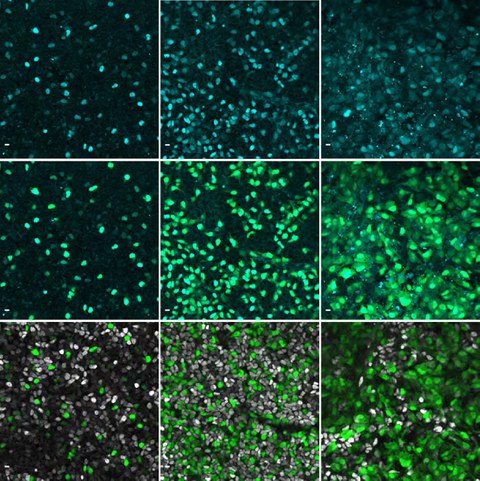Sep 11, 2023
Researchers from Dresden develop a map to study the behavior of early pancreas cells

Immunofluorescence images showing the gene NEUROG3 in cyan in human pancreatic cells.
The pancreas consists of various cells that are very important in controlling our blood sugar levels. If certain genes in these cells fail, for example due to a mutation, this can lead to the development of diabetes. One of these genes in pancreatic cells is neurogenin 3 (NEUROG3). This gene is only active for a short time during pancreatic development, but plays a key role in the differentiation of the endocrine cell types of the islets of Langerhans from epithelial progenitors. Researchers from Dresden and the Novo Nordisk Foundation at the University of Copenhagen have now used a special method to observe both the activity of the gene and the protein it makes in human pancreatic cells to better understand the gene. The results of the study have now been published in the renowned journal Developmental Cell.
Different cells in the pancreas control our blood glucose levels, for example the insulin-producing beta cells or the glucagon-producing alpha cells. Insulin helps to lower our blood glucose levels, while glucagon does the opposite and raises blood glucose levels. When beta cells these cells fail to function or die, we get diabetes. As our bodies are growing, all of these special cells originate from a single type of cell in the pancreas, the pancreatic endocrine progenitor cells. This cell type only uses the NEUROG3 gene for a short time to perform its task.
The team of Anne Grapin-Botton, managing director at the Max Planck Institute of Molecular Cell Biology and Genetics (MPI-CBG) and research group leader at the Paul Langerhans Institute Dresden, together with colleagues from the Novo Nordisk Foundation at the University of Copenhagen, set out to study these NEUROG3-expressing progenitor cells in the pancreas in more detail and to understand how this gene behaves in individual cells. "We have used fluorescent NEUROG3 to localize these cells. This allowed us to observe in live images how the cells move over time," explains Belin Selcen Beydag-Tasöz, first author of the study, and continues, "By looking at 2D and 3D models of the human pancreas, we found that the expression of the NEUROG3 gene was different in different cells. Some cells expressed the gene highly, while others expressed it weakly. Surprisingly, all cells in which NEUROG3 was detectable formed cells that produced hormones despite these differences. Another surprising finding of the study was that NEUROG3 works about two times slower in humans than in mice. This means that this gene takes more time to do its job in humans than in mice."
The team used a long-term live imaging method to observe a process that is normally hidden in the mother's womb. This made it possible to link the dynamic behavior of pancreatic cells observed in live images to all the genes they produce. This allows a better understanding of how the hormone-producing cells of the pancreas develop. In particular, the brightness of the cells helped them combine the activity of the genes with the behavior of the cells. In this way, the research team was also able to show that another gene called KLK12 ensures that the cells move to form islets of Langerhans as soon as the NEUROG3 gene starts working.
Anne Grapin-Botton, who led the study, summarizes: "The cell culture systems we have developed to understand how cells in human embryos form organs are beginning to bear fruit. In our study, we have learned much more about how the activity of certain genes during embryonic development can lead to diabetes later in life. These results can now help pave the way for more of these cells to be harvested for therapeutic purposes, such as for the production and transplantation of these cells into patients suffering from diabetes.
Original Publication
Belin Selcen Beydag-Tasöz, Joyson Verner D’Costa, Lena Hersemann, Byung Ho Lee, Federica Luppino, Yung Hae Kim, Christoph Zechner, Anne Grapin-Botton: Integrating single-cell imaging and RNA sequencing datasets links differentiation and morphogenetic dynamics of human pancreatic endocrine progenitors, Developmental Cell, 2023, https://doi.org/10.1016/j.devcel.2023.07.019.
